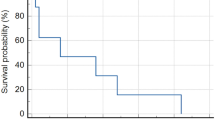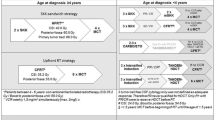Abstract
Purpose
The expression of PD-L1 in high-grade meningiomas made it a potential target for immunotherapy research in refractory cases. Several prospective studies in this field are still on going. We sought to retrospectively investigate the effects of check-point inhibitors (CI) on meningiomas that had been naïve to either surgical or radiation approaches by following incidental meningiomas found during treatment with CI for various primary metastatic cancers.
Methods
We used the NYU Perlmutter Cancer Center Data Hub to find patients treated by CI for various cancers, who also had serial computerized-tomography (CT) or magnetic-resonance imaging (MRI) reports of intracranial meningiomas. Meningioma volumetric measurements were compared between the beginning and end of the CI treatment period. Patients treated with chemotherapy during this period were excluded.
Results
Twenty-five patients were included in our study, of which 14 (56%) were on CI for melanoma, 5 (20%) for non-small-cell lung cancer and others. CI therapies included nivolumab (n = 15, 60%), ipilimumab (n = 11, 44%) and pembrolizumab (n = 9, %36), while 9 (36%) were on ipilimumab/nivolumab combination. We did not find any significant difference between tumor volumes before and after treatment with CI (1.31 ± 0.46 vs. 1.34 ± 0.46, p=0.8, respectively). Among patients beyond 1 year of follow-up (n = 13), annual growth was 0.011 ± 0.011 cm3/year. Five patients showed minor volume reduction of 0.12 ± 0.10 cm3 (21 ± 6% from baseline). We did not find significant predictors of tumor volume reduction.
Conclusion
Check-point inhibitors may impact the natural history of meningiomas. Additional research is needed to define potential clinical indications and treatment goals.
Similar content being viewed by others
Data availability
The datasets generated during and/or analyzed during the current study are available from the corresponding author on reasonable request.
References
Louis DN, Perry A, Wesseling P et al (2021) The 2021 WHO classification of tumors of the Central Nervous System: a summary. Neuro Oncol 23:1231–1251. https://doi.org/10.1093/neuonc/noab106
Islim AI, Mohan M, Moon RDC et al (2019) Incidental intracranial meningiomas: a systematic review and meta-analysis of prognostic factors and outcomes. J Neurooncol 142:211–221. https://doi.org/10.1007/s11060-019-03104-3
Patel B, Desai R, Pugazenthi S et al (2022) Identification and management of aggressive meningiomas. Front Oncol 12
Goldbrunner R, Minniti G, Preusser M et al (2016) EANO guidelines for the diagnosis and treatment of meningiomas. Lancet Oncol 17:e383–391. https://doi.org/10.1016/S1470-2045(16)30321-7
Sun SQ, Hawasli AH, Huang J et al (2015) An evidence-based treatment algorithm for the management of WHO Grade II and III meningiomas. Neurosurg Focus 38:E3. https://doi.org/10.3171/2015.1.FOCUS14757
Rogers L, Barani I, Chamberlain M et al (2015) Meningiomas: knowledge base, treatment outcomes, and uncertainties. A RANO review. J Neurosurg 122:4–23. https://doi.org/10.3171/2014.7.JNS131644
Shahbandi A, Shah DS, Hadley CC, Patel AJ (2023) The role of Pharmacotherapy in Treatment of Meningioma: a systematic review. Cancers (Basel) 15:483. https://doi.org/10.3390/cancers15020483
Kalluri AL, Shah PP, Lim M (2023) The Tumor Immune Microenvironment in primary CNS Neoplasms: a review of current knowledge and therapeutic approaches. Int J Mol Sci 24:2020. https://doi.org/10.3390/ijms24032020
Han SJ, Reis G, Kohanbash G et al (2016) Expression and prognostic impact of immune modulatory molecule PD-L1 in meningioma. J Neurooncol 130:543–552. https://doi.org/10.1007/s11060-016-2256-0
Karimi S, Mansouri S, Mamatjan Y et al (2020) Programmed death ligand-1 (PD-L1) expression in meningioma; prognostic significance and its association with hypoxia and NFKB2 expression. Sci Rep 10:14115. https://doi.org/10.1038/s41598-020-70514-z
Li YD, Veliceasa D, Lamano JB et al (2019) Systemic and local immunosuppression in patients with high-grade meningiomas. Cancer Immunol Immunother 68:999–1009. https://doi.org/10.1007/s00262-019-02342-8
Karimi S, Mansouri S, Nassiri F et al (2021) Clinical significance of checkpoint regulator programmed death ligand-1 (PD-L1) expression in meningioma: review of the current status. J Neurooncol 151:443–449. https://doi.org/10.1007/s11060-020-03584-8
Gelerstein E, Berger A, Jonas-Kimchi T et al (2017) Regression of intracranial meningioma following treatment with nivolumab: case report and review of the literature. J Clin Neurosci 37:51–53. https://doi.org/10.1016/j.jocn.2016.11.011
Dunn IF, Du Z, Touat M et al (2018) Mismatch Repair Deficiency in High-Grade Meningioma: a rare but recurrent event Associated with dramatic Immune activation and clinical response to PD-1 blockade. JCO Precision Oncology 1–12. https://doi.org/10.1200/PO.18.00190
Bi WL, Nayak L, Meredith DM et al (2022) Activity of PD-1 blockade with nivolumab among patients with recurrent atypical/anaplastic meningioma: phase II trial results. Neuro Oncol 24:101–113. https://doi.org/10.1093/neuonc/noab118
Aquilanti E, Brastianos PK (2020) Immune Checkpoint inhibitors for Brain metastases: a primer for neurosurgeons. Neurosurgery 87:E281–E288. https://doi.org/10.1093/neuros/nyaa095
Behbahani M, Skeie GO, Eide GE et al (2019) A prospective study of the natural history of incidental meningioma—hold your horses! Neuro-Oncology Pract 6:438–450. https://doi.org/10.1093/nop/npz011
Delgado-López PD, Montalvo-Afonso A, Martín-Alonso J et al (2021) Volumetric growth rate of incidental asymptomatic meningiomas: a single-center prospective cohort study. Acta Neurochir (Wien) 163:1665–1675. https://doi.org/10.1007/s00701-021-04815-1
Chen J, Li S, Yao Q et al (2020) The efficacy and safety of combined immune checkpoint inhibitors (nivolumab plus ipilimumab): a systematic review and meta-analysis. World J Surg Oncol 18:150. https://doi.org/10.1186/s12957-020-01933-5
Johnson MD (2018) PD-L1 expression in meningiomas. J Clin Neurosci 57:149–151. https://doi.org/10.1016/j.jocn.2018.08.023
Huang RY, Bi WL, Weller M et al (2019) Proposed response assessment and endpoints for meningioma clinical trials: report from the Response Assessment in Neuro-Oncology Working Group. Neuro Oncol 21:26–36. https://doi.org/10.1093/neuonc/noy137
Nidamanuri P, Drappatz J (2022) Immune checkpoint inhibitor therapy for recurrent meningiomas: a retrospective chart review. J Neurooncol 157:271–276. https://doi.org/10.1007/s11060-022-03979-9
Sheehan J, Pikis S, Islim AI et al (2021) An international multicenter matched cohort analysis of incidental meningioma progression during active surveillance or after stereotactic radiosurgery: the IMPASSE study. Neuro Oncol 24:116–124. https://doi.org/10.1093/neuonc/noab132
Acknowledgments
The authors would like to thank Megan D. Winner, MD, Victoria Lam, MS and Teija Hebshibah, MS from the Perlmutter Cancer Center Data Hub for providing support and data access for the purpose of this study.
Funding
The authors declare that no funds, grants, or other support were received during the preparation of this manuscript.
Author information
Authors and Affiliations
Contributions
AB and RM contributed to the study conception and design, data preparation and analysis were performed by AB, RM, KB and EM. The first draft of the manuscript was written by AB and RM and all authors reviewed previous versions of the manuscript and approved the final manuscript.
Corresponding author
Ethics declarations
Ethics approval
The study was approved by the NYU Langone Health Institutional Review Board.
Competing interests
The authors declare no competing interests.
Additional information
Publisher’s Note
Springer Nature remains neutral with regard to jurisdictional claims in published maps and institutional affiliations.
Rights and permissions
Springer Nature or its licensor (e.g. a society or other partner) holds exclusive rights to this article under a publishing agreement with the author(s) or other rightsholder(s); author self-archiving of the accepted manuscript version of this article is solely governed by the terms of such publishing agreement and applicable law.
About this article
Cite this article
Berger, A., Mullen, R., Bernstein, K. et al. Volumetric growth rate of incidentally found meningiomas on immunotherapy. J Neurooncol 166, 303–307 (2024). https://doi.org/10.1007/s11060-023-04558-2
Received:
Accepted:
Published:
Issue Date:
DOI: https://doi.org/10.1007/s11060-023-04558-2




